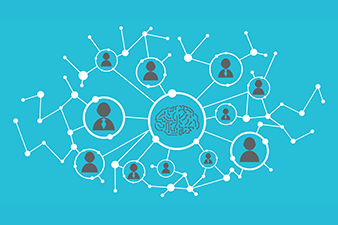
In recent years, individuals visiting customer service websites have been provided the option to engage in an online chat session, via an instant messaging service, with a contact center associate. Customers are also able to contact customer support without having to go to a website. According to IBM,[1] 70% of consumers say they prefer messaging over calling for customer support. Chat technologies, including live chat and chatbots, provide an opportunity for shared services centers to meet customer preferences and provide a new customer experience.
The Rise of Chat
Chat has numerous benefits, primarily instant interaction with a contact center associate without having to wait on hold or wait for an email response. Chat via social media further enables individuals to interact with customer support from their mobile phone using their preferred application. For example, chat can be made available via a variety of social media applications, such as Kik, Facebook Messenger, Twitter, and Slack.
Key Benefits of Chat

Today’s users want a fast response and instant gratification across the customer experience lifecycle. These changing customer expectations are also driving changes in the shared services world. According to SSON Analytics,[2] half of shared services organizations (SSOs) agreed that customer expectations have risen such that transaction processing and service excellence is only the minimum bar. The top measures of SSO success have become improved customer satisfaction and the simplicity of customer experience.
What Is a Chatbot?
While customers enjoy having quick access to support, they may be unaware that an increasing number of contact centers are utilizing chatbots, and their interactions may not be with a contact center employee.
There are two main types of chatbots—basic chatbots that respond to customer requests based on a series of scripts, and chatbots that utilize artificial intelligence (AI) to tailor responses to the type of inquiry. A complex or multi-part request might be difficult for a basic chatbot to answer. However, chatbots utilizing AI improve their responses with increased human interaction and are capable of answering more complex inquiries. AI adapts to customer expectations by using large data sets and predictive analytics. Large organizations with a high volume of customer interaction might find chatbots utilizing AI more effective for their organization. AI has the capacity to determine the context of customer questions and is more likely to provide a customized response. Customers are more likely to have a positive interaction with a chatbot once the problem-solving technology has been improved by continued user interaction.
Chatbots can provide a range of services from basic information search to answering questions to more complex troubleshooting and transactional capabilities. Companies often use chatbots for customer-facing interactions on websites, mobile, messaging platforms, and more recently Alexa, Google Assistant, and Siri. Oracle has declared that chatbots will be the number one customer-facing application of AI over the next five years.[3] A 2017 Aberdeen survey found that 23% of companies currently use chatbots as part of their customer experience technology mix.[4] Gartner predicts that by 2020, more than 50% of medium to large enterprises will have deployed chatbot solutions.[5]
Recently, companies also started piloting chatbots for employee-facing activities. In the U.K., Lloyds Bank created a chatbot to help employees navigate the organization’s entire knowledgebase. Recruitment chatbots, such as Jobo, Xor, and Joboti, can stage initial interviews that are direct, friendly, and minimally intimidating.
In the shared services world, chatbots are emerging as an agile solution for elevating employee experiences and optimizing transactional activities within corporate back office functions. Here are some potential use cases:
- HR – Chatbots can power recruiting departments by assisting throughout the candidate screening process and performing background checks. Employees can even use chatbots for professional development through personal chatbot coaches, such as Boldr.
- Finance – Chatbots can be used to solve common questions or queries from customers, including the latest account balances, when certain bills are due, and the status on accounts.
- Procurement – Chatbots can be the single point of contact for internal and external queries about purchase orders, invoices, and more. SAP Ariba launched an AI-powered chatbot in 2017, aiming to reduce delays in the invoicing process by learning buyer preferences and matching with supplier information.
- IT – Chatbots can address basic IT support issues and provide quick troubleshooting, spread awareness about IT policies and initiatives, and answer FAQs. Chatbots can also help the support staff in gathering data from multiple systems to check the previous inquiry records of the employee and keep track of the status of the ticket.
There are subtle but important differences between millennials and baby boomers in terms of their expectations of chatbots. According to a 2018 survey,[6] millennials are more likely to expect 24-hour service and an instant response, while baby boomers are emphasizing high-quality customer experiences from chatbots. Millennials, born in the digital era where on-demand services are driving business models across industries, serve as a prime example of a generation being targeted by tech advancement. As lifelong digital natives, Gen Z has also proven to have a special affinity for mobile communication and engagement. Kik reported that 60% of their chatbot users are between the ages of 13 and 19, with more females than males. Older generations remain much harder to target. They don’t naturally communicate by text and are apt to prefer real-life give and take with customer service representatives.
Limitations and Challenges
Despite the multitude of benefits, there are common limitations for companies seeking to implement chatbots. Chatbot effectiveness depends on repeated user experiences to make them more intuitive, and the technology is not yet developed enough to enable effortless dialogue between human and bot. Accessibility issues, lack of personality and conversational flow, and the inability to respond naturally or deliver smooth functionality can all result in customer frustration.
- Voice Recognition Errors – Although natural language processing has been improving rapidly, it is still far from perfect. Very often, voice recognition technology reacts to accents differently than humans. AI can only recognize what it’s been trained to hear. Its flexibility depends on the diversity of the accents to which it’s been introduced. Beyond regional dialects, individuals also develop unique patterns of speech, where syntax strays far from the rules of languages.
- Conversational Errors – Because there are so many different ways to express the same thing and an almost infinite number of things to say, no chatbot can understand everything that anyone could say. Much worse than not understanding at all is a bot thinking that it has understood when it hasn’t. A common misconception in the conversation design is to fail to recognize user corrections in their speech.
Other potential challenges include the significant costs and preparation required to implement chatbots. Implementation duration and cost vary depending on the complexity of the chatbot. Chatbots utilizing AI require far more development hours and ongoing support than a less advanced chatbot. Organizations with a lack of IT resources for up-front development and ongoing maintenance can be deterred from making the investment due to the amount of outside development assistance necessary for implementation. Additionally, preparation before development is necessary as chatbots require scripts or a knowledgebase from which to find answers to customer inquiries. Organizations without an existing knowledgebase can find themselves requiring additional preparation before the development of the chatbot can begin.
Recommendations
Chat has emerged as an important customer support tool, and customer preferences show increased demand for this option. Both live chat and chatbots can be effective solutions. However, as a result of the limitations and challenges, organizations can be reluctant to deploy chatbots to their external customers, fearing customers may have a negative experience. Piloting chatbots in a shared services center can be beneficial because internal customers might be more forgiving of chatbot growing pains. Best practices recommend that organizations experiment with non-critical business processes on chat platforms before company-wide deployment. Seasonal service center processes would be a good fit as long as there is the possibility of frequent customer interaction to improve the quality of the chatbot responses. Additionally, if chatbots are programmed to search knowledgebases and other internal content, internal customers benefit from the pilot by receiving 24-hour support for their inquiries and can access information quickly.
[1] IBM, How Chatbots Can Help Reduce Customer Service Costs by 30%, 2017
[2] SSON, Shared Services in North America: Millennial Talent, Digital Disruption & Customer Experience, 2018
[3] Oracle, Can Virtual Experiences Replace Reality, 2016
[4] Aberdeen, Chatbots in Customer Experience: The Modern Way to Sell More & Serve Better, 2017
[5] Gartner, Chatbots Will Appeal to Modern Workers, 2018
[6] The 2018 State of Chatbots Report
Additional Contributing Authors: Arielle Ennis, Min Qin






